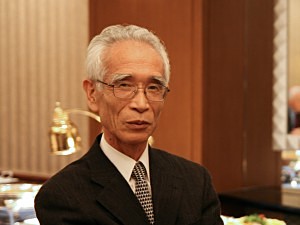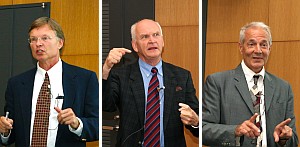Features
Features
On the one hand
- ツイート
- 2010/08/26
An international meeting on the science and technology of chiral chromatography held at Nagoya University in July 2010 pays tribute to the technique's Nagoya origins
Many molecules, including many families of industrially useful compounds, come in two mirror-image forms referred to as left- and right-handed enantiomers. This structural characteristic is called chirality, and it plays an important and increasingly useful role in chemical reactions and synthesis.
 Chiral chromatography, a technique for separating mixtures of chemical compounds with left- and right-handed chiral forms, is therefore of major importance for chemists in academia and industry alike. Prior to its invention in the late 1970s, processes for purifying chiral mixtures were limited, laborious and often unreliable. All this changed with the advent of the chiral chromatography revolution, in which Yoshio Okamoto, a former professor in the Department of Applied Chemistry of the Graduate School of Engineering at Nagoya University, played a pioneering role.
Chiral chromatography, a technique for separating mixtures of chemical compounds with left- and right-handed chiral forms, is therefore of major importance for chemists in academia and industry alike. Prior to its invention in the late 1970s, processes for purifying chiral mixtures were limited, laborious and often unreliable. All this changed with the advent of the chiral chromatography revolution, in which Yoshio Okamoto, a former professor in the Department of Applied Chemistry of the Graduate School of Engineering at Nagoya University, played a pioneering role.
Okamoto first became interested in chiral polymers while still an assistant professor at nearby Osaka University, but his career-making breakthrough came in 1979 when he became the first person in the world to synthesize a helical polymer of triphenylmethyl methacrylate in a single-handed form that was structurally stable at room temperature. He subsequently showed that the same synthetic principle could be used for chiral chromatography and commercialized the discovery soon after in partnership with Daicel, which is now a leading Japanese manufacturer of chiral chromatography media.
Wide-ranging implications
The profound effect of the development of chiral chromatography and its increasing importance in both academic and industrial contexts was one of the main themes of the Nagoya Symposium on Chiral Separation. The meeting, held at Nagoya University on July 9 with the support of the GCOE for the Elucidation and Design of Materials and Molecular Functions, drew around 100 participants who heard a series of five lectures by leading international figures in separation science. The wide-ranging program examined recent developments in techniques and applications of chiral chromatography, with perspectives from both academia and industry.

The pedigree of Nagoya University in the field of separation science is attributable in no small measure to the work of Okamoto, a point that was acknowledged by all five speakers. Introducing his lecture, Dan Armstrong from the University of Texas at Austin, USA, spoke of the important role that Okamoto and Nagoya University had played in advancing the science of chiral separation. Wolfgang Lindner of the University of Vienna, Austria, also acknowledged the profound impact of chiral chromatography, saying that the "resolution of enantiomers has mutated from art to routine." Eric Francotte, executive director at the Novartis Institute for Biomedical Research in Basel, Switzerland, paid a further personal tribute: "We really have to thank Yoshio for his immense contribution and help in the field of chiral separation." Echoing his comments, Shalini Andersson of AstraZeneca R&D in Molndal, Sweden, said that Okamoto had "a lot of people thanking him" and that his work had "made life a lot easier" for researchers. Christopher Welch of Merck & Co. in New Jersey, USA, went further, describing the invention of chiral chromatography as being worthy of the highest accolade and Okamoto as being "a perfectly valid candidate for a Nobel Prize" along with fellow chiral chromatography pioneers William Pirkle (University of Illinois at Urbana Champaign, USA) and Vadim Davankov (Russian Academy of Sciences, Russia).
A new way of working
Yet Okamoto -- who is currently a Distinguished Invited University Professor of Nagoya University and Chair Professor of Harbin Engineering University in China -- remains humble about his own contribution to chiral chromatography, and recalls his serendipitous entry into the field via his work on triphenylmethyl methacrylate. "To be honest, it is not what I originally investigated this type of polymer for. It was only later on that I realized the properties it possessed and thought that if its potential for chiral separation could be harnessed then it could be extremely useful. I only concentrated on discovering the actual chiral material and it was Daicel that did all the engineering and so forth that turned it into the chromatography column that has been so effective," says Okamoto. He is without any doubt regarding the technique's future, however. "I think that expanding the scope of chiral chromatography in an industrial setting is going to be the main thing -- using the technique on larger and larger scales will become increasingly important."
The continuing development of the science will also change the way that industry approaches the synthesis of 'chirally pure' materials in general, according to Okamoto. "I think that from now on we are going to see an increasing use of chiral chromatography as a time- and cost-effective way of getting to really high enantiomeric purity," he says, noting the considerable commercial incentives involved, especially in the case of pharmaceuticals. "If you can use chiral chromatography to help get your drug to market a year earlier, that's extremely important -- getting to market one year earlier means one more year of patent life, which carries enormous financial implications."
The field of separation science is the sort of interdisciplinary field at which Nagoya University excels, and Okamoto has his own ideas as to why this may be. "I think the fact that we are given quite a lot of freedom to do our own research has a lot to do with it. Even if your research doesn't have a concrete goal at the outset, people have the opportunity to follow the work where it takes them," he says.
The Nagoya Symposium on Chiral Separation was sponsored and organized by the Elucidation and Design of Materials and Molecular Functions GCOE program of the Department of Chemistry.
NU Research
(English)

